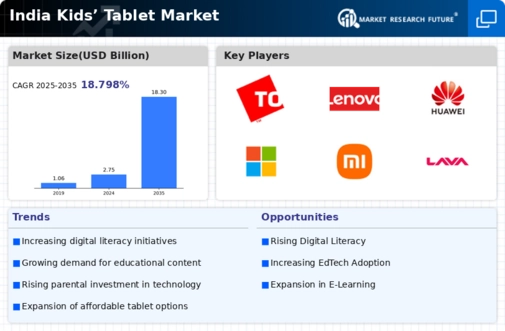The kids tablet market in India is currently characterized by a dynamic competitive landscape, driven by increasing demand for educational technology and digital learning tools. Major players such as Amazon (US), Samsung (KR), and Lenovo (CN) are actively shaping the market through strategic innovations and partnerships. Amazon (US) has positioned itself as a leader in the segment by leveraging its extensive ecosystem, focusing on integrating educational content with its devices. Samsung (KR) emphasizes technological advancements, particularly in display and battery life, to enhance user experience. Meanwhile, Lenovo (CN) is concentrating on affordability and accessibility, targeting a broader demographic of families seeking value in educational products. Collectively, these strategies contribute to a competitive environment that is increasingly focused on innovation and user engagement.
Key business tactics within the market include localizing manufacturing and optimizing supply chains to reduce costs and improve delivery times. The competitive structure appears moderately fragmented, with several players vying for market share. However, the influence of key players like Amazon (US) and Samsung (KR) is substantial, as they set benchmarks for quality and innovation that smaller competitors strive to meet.
In October 2025, Amazon (US) announced a partnership with a leading Indian educational content provider to enhance its tablet offerings with localized learning materials. This strategic move is likely to strengthen Amazon's position in the market by catering to the specific educational needs of Indian children, thereby increasing customer loyalty and engagement. The integration of localized content may also serve to differentiate Amazon's products from competitors, who may not offer the same level of tailored educational resources.
In September 2025, Samsung (KR) launched a new line of kids tablets featuring advanced parental control features and educational apps designed in collaboration with child development experts. This initiative reflects Samsung's commitment to safety and educational value, which could resonate well with parents concerned about screen time and content appropriateness. By focusing on these aspects, Samsung (KR) may enhance its appeal to health-conscious consumers, potentially increasing its market share.
In August 2025, Lenovo (CN) introduced a budget-friendly tablet specifically designed for the Indian market, featuring robust educational tools and a durable design. This strategic decision appears to target the growing segment of price-sensitive consumers, allowing Lenovo to capture a larger share of the market. The emphasis on affordability, combined with quality educational content, positions Lenovo (CN) favorably against competitors who may not offer similar value propositions.
As of November 2025, current trends in the kids tablet market include a strong focus on digitalization, sustainability, and the integration of artificial intelligence (AI) in educational tools. Strategic alliances among companies are increasingly shaping the landscape, as partnerships enable the sharing of resources and expertise. Looking ahead, competitive differentiation is likely to evolve from traditional price-based competition to a focus on innovation, technology integration, and supply chain reliability. Companies that can effectively leverage these trends may secure a competitive edge in the rapidly changing market.





















Leave a Comment